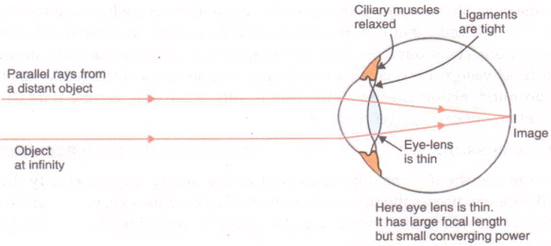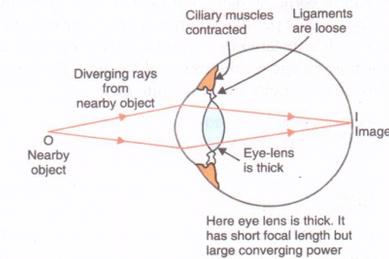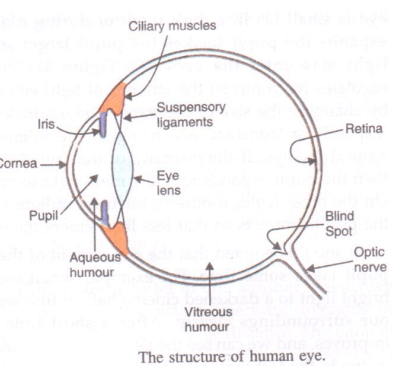Lakhmir Singh & Manjit Kaur: The Human Eyes And The Colorful World, Solutions- 2 | Science Class 10 PDF Download
Page No:271
Question 33: A person walking in a dark corridor enters into a brightly lit room :
(a) State the effect on the pupil of the eye.
(b) How does this affect the amount of light entering the eye ?
Solution : (a) Pupil becomes smaller.
(b) The amount of light entering the eye is reduced.
Question 34: Ciliary muscles of human eye can contract or relax. How does it help in the normal functioning of the eye ?
Solution : Ciliary muscles get relaxed and the eye lens becomes thin when the eye is looking at a distant object, and these muscles contract and make the eye-lens thick when the eye is looking at a nearby object. Thus, ciliary muscles help in the normal functioning of the eye by changing the thickness of the eye-lens while focussing.
Question 35: Describe and explain, how a normal eye can see objects lying at various distances clearly.
Solution : To focus on distant objects, the ciliary muscles of the eye get fully relaxed and pull the suspensory ligaments attached to the eye-lens tightly. This, in turn, stretches the eye-lens and the eye-lens becomes thin. This thin eye-lens has large focal length and small converging power sufficient to converge the parallel rays of light coming from a distant object to form an image on the retina.

An eye focused on a distant object (at infinity).
To focus on nearby objects, the ciliary muscles of the eyes contract and make the suspensory ligaments loose. The ligaments then stop pulling the eye-lens. The eye-lens bulges under its own elasticity and becomes thick. This thick eye-lens has small focal length and large converging power which converges the diverging rays coming from the nearby object to form an image on the retina.

An eye focused on a nearby object
Question 36: There are two types of light-sensitive cells in the human eye :
(a) Where are they found ?
(b) What is each type called ?
(c) To what is each type of cell sensitive ?
Solution : (a) The two types of light-sensitive cells are found in the retina.
(b) They are called rods and cones.
(c) Rods are sensitive to dim light and cones are sensitive to bright light and colours.
Question 37: What are rods and cones in the retina of an eye ? Why is our night vision relatively poor compared to the night vision of an
owl ?
Solution : Rods are the rod-shaped cells present in the retina of an eye which are sensitive to dim light.
Cones are the cone-shaped cells present in the retina of an eye which are sensitive to bright light.
Our night vision is relatively poor compared to the night vision of an owl due to the presence of relatively smaller number of rod cells in the retinas of our eyes.
Question 38: (a) How does the convex eye-lens differ from the ordinary convex lens made of glass ?
(b) List, in order, the parts of the eye through which light passes to reach the retina.
Solution : (a) The focal length of the convex eye-lens can be changed by the action of ciliary muscles, but the focal length of the ordinary convex lens made of glass is fixed.
(b) Cornea, pupil, eye-lens, retina.
Question 39: (a) What happens to the size of pupil of our eye
- in dim light
- in bright light ?
(b) Name the cells on the retina of an eye which are sensitive to
- bright light
- dim light
- sensation of colour.
Solution :
(a)
- In dim light, pupil becomes large.
- in bright light, puoil becomes small.
(b)
- Cones
- Rods
- Cones
Question 40: (a) Draw a simple diagram of the human eye and label clearly the cornea, iris, pupil, ciliary muscles, eye-lens, retina, optic nerve and blind spot.
(b) Describe the working of the human eye with the help of the above diagram.
(c) How does the eye adjust itself to deal with light of varying intensity ?
Solution :

(b) Working of the human eye
The light rays coming from the object kept in front of the eye enter the cornea, pass through the pupil and fall on the eye lens. The eyes lens is convex lens, so it converges the light rays and produces a real and inverted image of the object on the retina. The image formed on the retina is conveyed to the brain by the optic nerve and gives rise to the sensation of vision.
(c) The eye adjusts itself to deal with ight of vaying intensity with the help of the iris. The iris automatically adjusts the size of the pupil according to the intensity of light received by the eye. If the intensity of light is large, then iris contracts the pupil and reduces the amount of light entering the eye. And, if the intensity of light is small, then iris expands the pupil so that more light may enter the eyes.
Question 41: (a) Explain the functions of the following parts of the eye :
(a) cornea (b) iris (c) pupil (d) ciliary muscles (e) eye-lens(f) retina (g) optic nerve
(b) If you walk from a dark room into sunlight and back again into dark room, how would your pupils alter in size ? What makes this happen ?
(c) Explain why, we cannot see our seats first when we enter a darkened cinema hall from bright light but gradually they become visible.
Solution : (a) a. Cornea: It is the front part of the eye. The light coming from objects enters the eye through cornea.
b. Iris: It controls the amount of light entering the eye.
c. Pupil: It controls the illumination in the eye.
d. Ciliary muscles: The focal length of the eye-lens can be changed by changing its shape by the action of ciliary muscles.
e. Eye-lens: It focuses light on to the retina.
f. Retina: It is a delicate membrane having a large number of light sensitive cells called ‘rods’ and ‘cones’ which respond to the intensity of light and colour of objects respectively.
g. Optic nerve: It conveyes the image formed on the retina to the brain.
(b) If we walk from a dark room into sunlight, the pupil of the eye contracts. On again entering the dark room, the pupil of the eye expands.
(c) When we enter a darkened cinema hall from bright sunshine, at first we cannot see our seats clearly but gradually they become visible. This is because in bright sunshine the pupil of our eye is small and when we just enter the darkened room very little light enters our eye due to which we cannot see properly. After a while, when the pupil of our eye expands, more light enters our eye and we can see clearly.
Page No:272
Question 53: he descriptions of five kinds of images are given below :
(a) diminished and virtual
(b) enlarged and real
(c) enlarged and erect
(d) real and inverted
(e) virtual and the same size
Which one of these describes the image formed :
- on the retina of the eye ?
- by a magnifying glass ?
- by a convex driving mirror on a car ?
- by a plane mirror ?
- on the screen of a slide projector ?
Solution :
- d
- c
- a
- e
- b
Question 54: What shape are your eye-lenses :
(a) when you look at your hand ?
(b) when you look at a distant tree ?
Solution : (a) Thick
(b) Thin
Question 55: Suggest how your irises help to protect the retinas of your eyes from damage by bright light.
Solution : Irises help to protect the retinas of our eyes from damage by bright light by adjusting the size of the pupil according to the intensity of light received by the eye.
Question 56: (a) Which parts of the eye cause rays of light to converge on the retina ?
(b) Which part causes the greatest convergence ?
(c) Which part brings the image into sharp focus on the retina ? How does it do this ?
Solution : (a) Cornea and eye-lens
(b) Cornea
(c) Eye lens
By changing its thickness and hence conversing power.
Question 57: An object is moved closer to an eye. What changes must take place in the eye in order to keep the image in sharp focus ?
Solution : Ciliary muscles should change the shape of eyes-lens to make it thicker and increase its converging power.
Question 58: Why does the eye-lens not have to do all the work of converging incoming light rays ?
Solution : The eye-lens does not have to do all the work of converging incoming light rays because cornea of the eye also converges light rays entering the eye.
Question 59: Explain why, when it is getting dark at night, it is impossible to make out the colour of cars on the road.
Solution : The color detecting cells of the retina of the eye called ‘cones’ do not work well in dim light.
Question 60: Nocturnal animals (animals which sleep during the day and come out at night) tend to have wide pupils and lot of rods in their retinas. Suggest reasons for this.
Solution : Wide pupils allow more light to enter the eye during night.
Rod cells in the retina are sensitive to dim light and hence help in seeing properly at night.
Page No:279
Question 1: Name one of the common defects of vision and the type of lens used to remove it.
Solution : Defect: Myopia; Corrected by using concave lens.
Question 2: Name the defect of vision in a person :
(a) whose near point is more than 25 cm away.
(b) whose far point is less than infinity
Solution : (a) Hypermetropia
(b) Myopia
Question 3: Which defect of vision can be rectified :
(a) by using a concave lens ?
(b) by using a convex lens ?
Solution : (a) Myopia
(b) Hypermetropia
Question 4: What type of lens is used to correct
(a) hypermetropia
(b) myopia ?
Solution : (a) Convex lens
(b) Concave lens
Question 5: What is the other name for
(a) myopia (b) hypermetropia ?
Solution : (a) Near Sightedness
(b) Far Sightedness
Question 6: What is the scientific name of
(a) short-sightedness, and
(b) long-sightedness ?
Solution : (a) Myopia
(b) Hypermetropia
Question 7: What kind of lens is used to correct (a) short-sightedness (b) long-sightedness ?
Solution : (a) Concave lens
(b) Convex lens
Question 8: State whether the following statement is true or false :
Short-sightedness can be cured by using a concave lens.
Solution : True
Question 9: Name the defect of vision in which the eye-lens loses its power of accommodation due to old age.
Solution : Presbyopia
Question 10: Name the defect of vision which makes the eye-lens cloudy resulting in blurred vision.
Solution : Cataract
Question 11: What is the other name of old age hypermetropia ?
Solution : Presbyopia
Question 12: Name any two defects of vision which can be corrected by using spectacles.
Solution : (a) Myopia
(b) Hypermetropia
Question 13: Name one defect of vision (or eye) which cannot be corrected by any type of spectacle lenses.
Solution : Cataract
Question 14: Name the body part with which the terms myopia and hypermetropia are connected.
Solution : Eye
Question 15: What is the far point of a person suffering from myopia (or short-sightedness) ?
Solution : Less than infinity.
Question 16: Where is the near point of a person suffering from hypermetropia (or long-sightedness) ?
Solution : The near point of a person suffering from hypermetropia is farther away from the normal near point (25 cm).
Question 17: Your friend can read a book perfectly well but cannot read the writing on blackboard unless she sits on the front row in class.
(a) Is she short-sighted or long-sighted ?
(b) What type of lenses-converging or diverging-would an optician prescribe for her ?
Solution : (a) Short-sighted
(b) Diverging lenses
Question 18: A man can read the number of a distant bus clearly but he finds difficulty in reading a book.A man can read the number of a distant bus clearly but he finds difficulty in reading a book.
(a) From which defect of the eye is he suffering ?
(b) What type of spectacle lens should he use to correct the defect ?
Solution : (a) Hypermetropia (Long Sightedness)
(b) Convex lens
Question 19: A student sitting in the last row of the class-room is not able to read clearly the writing on the blackboard.
(a) Name the type of defect he is suffering from.
(b) How can this defect by corrected ?
Solution : (a) Myopia (Short – Sightedness)
(b) Concave lens
Question 20: Complete the following sentences :
(a) A short-sighted person cannot see ……….. objects clearly. Short-sightedness can be corrected by using
……… lenses.
(b) A long-sighted person cannot see…………. objects clearly. Long-sightedness can be corrected by using
………. lenses.
Solution : (a) distant, concave
(b) nearby, convex
|
80 videos|569 docs|80 tests
|
FAQs on Lakhmir Singh & Manjit Kaur: The Human Eyes And The Colorful World, Solutions- 2 - Science Class 10
| 1. How does the human eye perceive color? |  |
| 2. Why do some people have different color perception? |  |
| 3. What is the role of the lens in the human eye? |  |
| 4. How does the eye adjust to different lighting conditions? |  |
| 5. Can the human eye see all colors? |  |
















